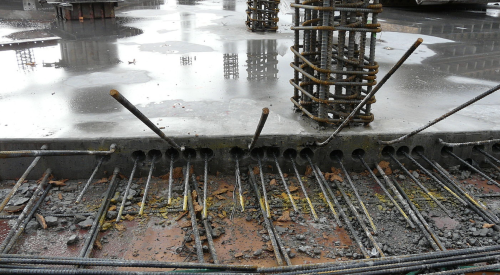 Permeable pavers provide a powerful first impression that can increase your homes' curb appeal. Photo credit: Sage Homebuilders |
Because engineered curb and gutter storm drainage systems are costly to design and build, permeable pavement systems can often reduce overall construction costs for home builders.
I initially thought that permeable pavement was significantly more expensive and that the benefits wouldn't justify the cost. But after doing a little research and experimentation, I've been proven wrong. Permeable paving systems typically cost more than conventional pavement, but any additional paving cost is offset, at least in part, because there is less need for stormwater management infrastructure. Catch basins, stormwater ponds, curbs, gutters and storm drains can be eliminated or downsized. As a result, permeable paving has become a standard part of our company's repertoire.
As with so many green building features, doing the right thing for the environment also has some nice benefits for the builder and the homeowner.
Builders can benefit because:
- Minimizing storm water management issues simplifies planning
- Permeable paving puts money in the developer's pocket because there's no need to install costly water collection and detention areas
- Eliminating collection and detention areas increases the effective developable area, which also saves the developer money
- Builders can receive points on green certification programs
Benefits to the homeowner include:
- A safer surface that's easier to grip and is less likely to ice over
- Less chance of erosion and water seeping into basements
- A better appearance because permeable pavement eliminates the need for ugly surface runoff measures
- Lower maintenance costs because permeable surfaces require fewer repairs and need to be resurfaced less often
- More water to the root systems of plants and trees in the vicinity, resulting in healthier vegetation
The primary downsides of permeable paving are the higher initial cost of the paving itself and the need for regular cleaning to prevent clogging. A secondary consideration is that most permeable asphalts and concretes are not approved for heavy traffic loads.
Choosing a SurfaceThere are generally four options for permeable pavement: permeable pavers; permeable asphalt; permeable concrete; and permeable plastic or metal grids that hold grass or gravel in place.
- Permeable Pavers. For most residential applications, we tend to use pavers. These include block, brick, stone and other interlocking paving materials. Compared to conventional concrete and asphalt, they're less likely to crack over time, can be installed more quickly and are less expensive to repair if they do crack or move.
- Permeable Asphalt. The same mixing and application equipment is used for porous bituminous (permeable) asphalt as for impervious asphalt; only the formula for the paving material changes. Another promising asphalt product is Firestone's Flexi-Pave, a permeable asphalt made largely from recycled tires. It retains the elasticity of rubber, which means it will be more shock absorbent, crack less, clog less and provide better grip than conventional asphalt.
- Permeable Concrete. This type of concrete requires larger pea gravel and a lower water-to-cement ratio, resulting in a pebbled, open surface that is roller compacted. Maintenance for both permeable concrete and permeable asphalt is generally the same — regular clearing of debris from the surface to prevent clogging of the "pores."
- Grids. The grid system achieves a more durable gravel or grass surface that allows water to pass through easily. The high-strength plastic grid provides a structural framework that holds gravel or grass in place and prevents compaction and erosion. As with all green features, making permeable pavement work requires educating the home buyer on the benefits and the importance of proper maintenance.
Installation is similar for permeable pavement as for conventional paving. First, crews excavate to the design depth of the pavement/gravel reservoir system. Then, the uncompacted base soil is covered with a geotextile fabric to reduce migration of soil fines into the gravel base. The permeable paving — be it pavers, asphalt, concrete or grid — is then placed. A word of caution: monitor the installer to ensure proper installation of the base rock, which can greatly affect the performance of the paving.
|
Check out these sites for more information: |
| Author Information |
| Rick Hunter is Managing Principal of Sage Homebuilders, a green builder in St. Louis. He writes on behalf of the Partnership for Advancing Technology in Housing (PATH), which is administered by the U.S. Department of Housing and Urban Development. Learn more about PATH at www.pathnet.org; learn more about Sage Homebuilders and green building at www.sagestl.com. |










